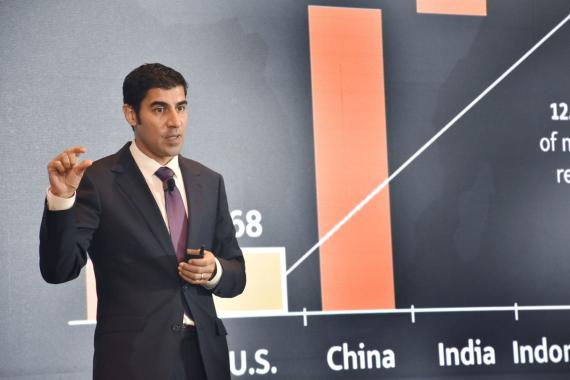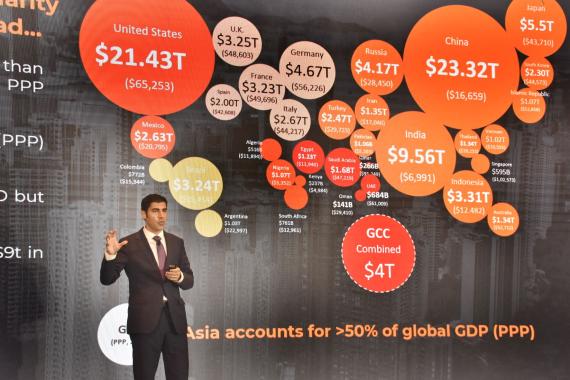On November 9th the World Gold Council held an EVOLVE Investment Summit in Singapore. Our series of EVOLVE conferences explore the trends and issues shaping the future of finance. What happens in Asia is hugely significant for the gold market. India and China are the largest gold consuming markets, and other markets in the region including Singapore, Hong Kong and Japan are major trading centres for gold. In a blog for Goldhub, Dr Parag Khanna, one of this year’s keynote speakers, writes about the shifting economic centre of gravity and Asia’s role in the global economy.
Asia evolves: what's next for the world's center of gravity?
22 November, 2021
World trade and economic activity have centered around Asia for much of history. And as in the past, Asia’s current economic ascent isn’t solely a consequence of developments in China and India, but also of sustained growth in West and Southeast Asia. These latter regions -- which I term ‘Ascending Asia’ -- are making large contributions to Asia’s overall growth, which represents half the world’s total projected GDP growth through 2050. Already, Asia’s exports and imports account for two-thirds of global trade. Its middle class is projected to reach 3 billion by 2030, representing 60% of the world’s total. And by 2040, the Asian middle class is forecast to drive 40% of global consumption.
Underpinning Asia’s sanguine growth forecasts are its strong macroeconomic fundamentals, a growing youth population, as well as strengthening intra-regional trade and investment flows. 8 of the 10 biggest FX reserve holdings are in the GCC and Asia. The large foreign exchange buffers make sharp capital outflows less likely, and to the extent they do occur, less destabilizing. Asia’s major currencies have also been less volatile in recent years, a consequence of greater local currency borrowing. These large savings pools have helped keep debt-to-GDP ratios relatively low across most of Asia. To the extent that Asian governments have engaged in significant sovereign borrowing, it is often to finance developments in infrastructure, education and other sectors driving long-term growth.
In addition to strong FX reserves, and prudent borrowing, Ascending Asia is increasingly marked by stable and low inflation; a trend the IMF expects to continue, with consumer price inflation projected to stay below 5% through 2026. With strong macro fundamentals, large and mid-cap equities in Asia’s emerging markets continue to outperform their counterparts in emerging markets outside Asia, with the gap widening to nearly 300 points on the MSCI EM Index since the outbreak of Covid-19.
The median age in most Asian countries remains under 30. Notably, even as China ages, it retains a sizable population of young people, with 700 million Chinese below age 40. Additionally, the number of 15-24 year olds across MENA is forecast to increase by over 30% over the next decade, making it the region with the fastest growing youth population in the world. With over 820 million working age millennials, and approximately 2 billion under the age of 40, global growth will increasingly centre around Asia, especially as aging trends in Europe and America accelerate.
Asia’s economic rise is marked by a strengthening of intra-regional trade and investment flows. Nearly 60% of exports originating in Asian countries are destined for other markets in Asia. Notably, GCC’s trade with China, Japan, and India now totals over $550 billion; with India and China, seeing a 4x and 5x rise in GCC imports respectively between 2008-18. Over half of Asia’s FDI flows are also intra-regional, reflecting deepening ties between financial systems and corporate sectors. These trends are likely to accelerate post-pandemic, as more Asians stay in Asia for holidays and education, spending their money and starting businesses within the region.
Over the long-term, Asia-led frameworks including the Regional Comprehensive Economic Partnership (RCEP) will further strengthen intra-regional trade and investment flows. With 3.6 billion consumers, and 30% of global GDP, RCEP is fast emerging as the world’s largest free trade zone. For ASEAN, improved market access through RCEP could increase regional GDP by $19 billion annually by 2030.
East and West Asia’s deepening trade and investment networks indicate that capital, companies, and consumers will increasingly traverse the Indian Ocean and strengthen ties along the new Silk Roads, stitching the region into a whole greater than the sum of its parts. As we look to the future, it becomes increasingly difficult to imagine a global portfolio that doesn’t include strong exposure to Ascending Asia.


